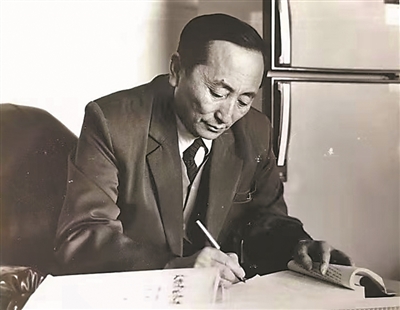
 0 Comment(s)
0 Comment(s) Print
Print E-mail People's Daily Online, April 15, 2025
E-mail People's Daily Online, April 15, 2025
Devoting more than six decades to the preservation and study of the music of the Mongolian ethnic group in China, Wu Lanjie, an 87-year-old Chinese musicologist and educator, has made significant contributions to the inheritance and development of the music, with his important monographs forming a theoretical framework for Mongolian music history.
Born into a family of folk song artists on the Horqin Grassland in north China's Inner Mongolia Autonomous Region, Wu was immersed in Mongolian folk songs from an early age and developed a deep passion for music, which later evolved into a lifelong pursuit.
As Wu described it, he has spent nearly his entire life creating an extensive "coordinate system" for Mongolian music, with the horizontal axis representing the timeline of its development from ancient times to the present, and the vertical axis categorizing the various forms of the music—such as folk songs, instrumental music, and epics—thus forming a comprehensive theoretical framework.
In particular, his landmark work, a book titled "A History of Mongolian Music," serves as an academic compass tracing the vibrant evolution of Mongolian music, advancing the theorization and systematization of the music.
The work was a result of more than 30 years of painstaking efforts starting from 1959, when he was studying at the musicology department of China's Central Conservatory of Music.
"After studying the history of music from different parts of the world, I couldn't help but wonder—Mongolian ethnic music is so rich and diverse, how could it not have a history of its own?" Wu recalled, noting that a simple yet powerful idea took root in his mind at the time: to write a book on the history of Mongolian ethnic music.
In the decades that followed, Wu embarked on a monumental project to collect, analyze, and categorize Mongolian ethnic music.
"In the past, most studies of Mongolian ethnic music remained at the level of general overviews, lacking theoretical depth, systematic structure, and professional rigor," Wu said.
"In such circumstances, no matter how abundant the musical works are, musical creation and music education cannot develop in a systematic way. Only by elevating musical practices of the Mongolian people to the level of music theory and history can we lay a solid foundation for their inheritance and development," he explained.
In an effort to compile a comprehensive history of Mongolian ethnic music, Wu nearly exhausted every available source he could find. He combed through a vast range of materials—from ancient Mongolian-language texts and classical Chinese literature, such as the treatise on ritual and music in the "Book of Han", to collections of works by literary figures and scholars from the Yuan, Ming, and Qing dynasties.
He also consulted foreign works, including "The Travels of Marco Polo", and explored archaeological findings in search of historical references to Mongolian ethnic music.
Realizing that he couldn't rely solely on books, Wu also took to the grasslands to conduct field research. During the summers of 1963 and 1964, he traveled from village to village, consulting with local folk singers and documenting what he heard.
The journeys were long and often dangerous—he once encountered wolves, and on another occasion nearly drowned while crossing a river. Instinctively, he held his backpack full of folk song transcriptions above his head, which caught the attention of a passerby who came to his rescue.
Through his fieldwork, Wu collected and preserved over 300 folk songs, including more than 90 long-tune songs (Urtyn duu), which are praised as a "living fossil" of Mongolian music.
"At that time, many people thought that the long-tune folk songs from the Horqin Grassland were on the verge of disappearing, with only about a dozen surviving. However, I managed to collect over 90 of them," Wu recalled.
Based on his rescue efforts that contributed to the preservation of the long-tune folk songs from the Horqin Grassland, Wu published a book on the traditional form of folk music.
Wu's extensive fieldwork laid a solid foundation for his scholarship. After more than 30 years of research and documentation, he began writing "A History of Mongolian Music" in 1993. The book was published five years later, earning widespread acclaim and being included in the inaugural Yang Yinliu nomination for academic achievements in music by the Chinese National Academy of Arts. The nomination represents one of the most prestigious honors for musicians in China.
Yet he didn't stop there. A revised edition came out in 2019, enriched with new findings, updated theories and historical data, as well as contemporary developments.

A photo of Wu Lanjie, an 87-year-old Chinese musicologist and educator, in his earlier years. [Photo courtesy of the interviewee]
Today, he remains deeply engaged in the preservation and development of ancient folk songs. As a researcher at Minzu University of China and a special doctoral supervisor at the China Conservatory of Music, he continues to mentor young scholars and advocate for the fusion of tradition and innovation.
Hanggai, a band with ethnic Mongolian musicians, has successfully blended traditional Mongolian music with modern elements, attracting more modern audiences to Mongolian folk songs, Wu said, noting that this kind of revival is what he hopes for.
Despite health challenges and a worn-out knee from years of travel, Wu still works with untiring vigor. He is busy with mentoring students, promoting music, and conducting academic research.
"There's still a lot I haven't finished," he said. "I have a '510 writing plan'—the materials I've collected from fieldwork could still form the basis for five theoretical monographs; the folklore and historical stories I've accumulated over the years could fill 10 more books. I am determined to finish writing all these and leave more research materials for the younger generation."